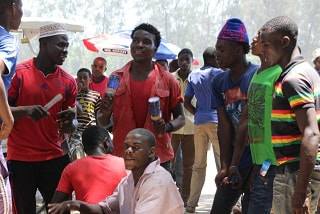
UNAIDS’ latest report shows the world is moving forward in achieving the 90-90-90 agenda. The targets were launched in 2014 to accelerate progress so that by 2020, 90% of all people living with HIV know their HIV status, 90% of all people with diagnosed HIV have access to sustained antiretroviral therapy and 90% of all people with access to antiretroviral therapy are virally suppressed.
Current state of affairs
Today, more than half of all people living with HIV (53%) have access to HIV treatment. More than two thirds (70%) of all people with HIV know their status and of those people who know their status, 77% has access to treatment. Within this group, 82% has its viral load suppressed.
Seven countries reached the goals already
Eastern and Southern Africa, Western and Central Europe, North America and Latin America are regions on track to reach the 90-90-90 goals. Seven countries have already achieved this: Botswana, Cambodia, Denmark, Iceland, Singapore, Sweden and the United Kingdom. Other countries, including Belgium, are on the verge of doing so.
Criticism
AVAC, the Aids Vaccine Advocacy Coalition, an international coalition that advocates HIV prevention is critical about the report. According to AVAC, UNAIDS puts too much emphasis on the biomedical uptake of HIV at the cost of primary prevention.
Furthermore, AVAC regrets the delayed implementation of condom and male circumcision programmes and the fact that access to PrEP is limited to only a handful of countries.
Epidemic amongst African youth
AVAC has also issued warnings for the HIV epidemic among young people in Sub-Saharan Africa. Many African countries count twice as many young people living with HIV as they did at the start of the epidemic.
In 2016, the number of new HIV diagnoses among 15-24 year old African girls and women was 44 per cent higher than among men of the same age. In line with demographic developments, the number of HIV diagnoses in African youths will continue to rise. The current HIV prevention strategies do not suffice to effectively end the HIV epidemic among young people.
Today, more than half of all people living with HIV (53%) have access to HIV treatment. More than two thirds (70%) of all people with HIV know their status and of those people who know their status, 77% has access to treatment. Within this group, 82% has its viral load suppressed.
Seven countries reached the goals already
Eastern and Southern Africa, Western and Central Europe, North America and Latin America are regions on track to reach the 90-90-90 goals. Seven countries have already achieved this: Botswana, Cambodia, Denmark, Iceland, Singapore, Sweden and the United Kingdom. Other countries, including Belgium, are on the verge of doing so.
Criticism
AVAC, the Aids Vaccine Advocacy Coalition, an international coalition that advocates HIV prevention is critical about the report. According to AVAC, UNAIDS puts too much emphasis on the biomedical uptake of HIV at the cost of primary prevention.
Furthermore, AVAC regrets the delayed implementation of condom and male circumcision programmes and the fact that access to PrEP is limited to only a handful of countries.
Epidemic amongst African youth
AVAC has also issued warnings for the HIV epidemic among young people in Sub-Saharan Africa. Many African countries count twice as many young people living with HIV as they did at the start of the epidemic.
In 2016, the number of new HIV diagnoses among 15-24 year old African girls and women was 44 per cent higher than among men of the same age. In line with demographic developments, the number of HIV diagnoses in African youths will continue to rise. The current HIV prevention strategies do not suffice to effectively end the HIV epidemic among young people.

 RSS Feed
RSS Feed